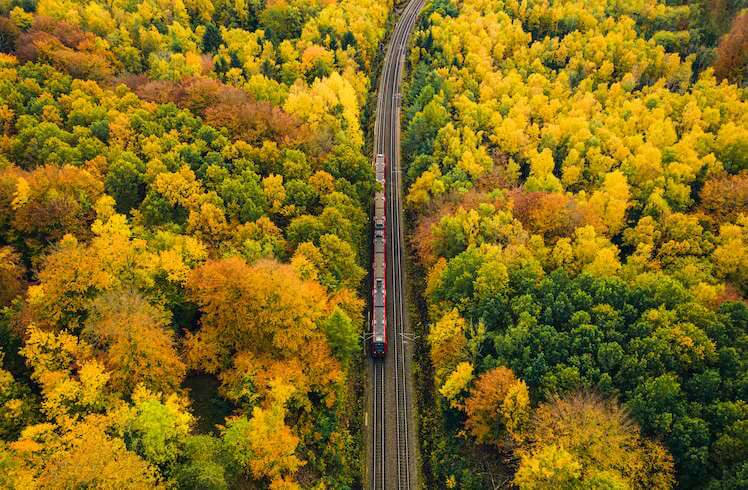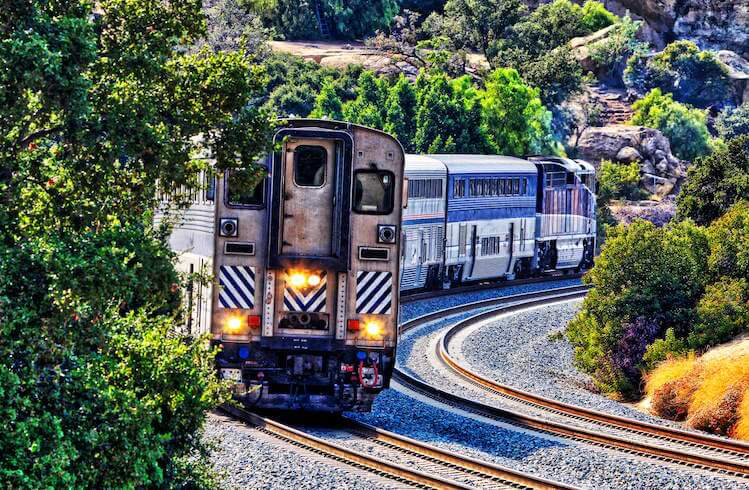The Return of Train Travel – Why It Matters to the Planet
As travelers try to balance a desire to explore the world with trying to battle the causes of climate change, could traveling by train be the answer?
 Photo © Getty Images / Jonathan Filskov Photography
Photo © Getty Images / Jonathan Filskov Photography
- Train travel makes a comeback
- Breakdown of environmental benefits
- Sustainable advances and the future of the train industry
- Global train adventures
The unsteady tempo of the train lurched back and forth, carving its way through steep emerald tea fields. Standing on the edge of the open doorway, I allowed the wind and rain to tickle my face as we made our ascent into Sri Lanka's vivid hill country. I had the best place on board, privy to the ever-changing climate and scenery, watching small towns, Buddhist relics, and plantations pass by. Behind me, the train car was flooded with chaotic and joyful music as a Sri Lankan family beat drums and sang to the rhythm of the train. I smiled to myself, reminded that the actual journey adds a level of depth and element of surprise to travel that the destination simply cannot.
Train travel makes a comeback
Before traveling in the great blue sky became as common as taking the bus, there was a time when overland travel by train wasn’t just a trend, it was the norm. Train travel to destinations near and far was once a leading means to adventure across the globe (unless you had to cross an ocean, that is). During the mid-20th century, airplanes slowly started to become the standard rather than a luxury mode of transport and in 1955, for the first time, more people in the United States traveled by plane than train. The world hasn’t really looked back since, as an explosion of air travel shrunk the globe, turning once days-, if not weeks- or months-long travel into mere hours. The consequences on the environment have been dire, as aviation travel is responsible for 2.5% of global carbon emissions and road travel accounts for approximately 10% of these direct emissions.
In an age where slow, intentional travel is finding its place again and green living takes center stage, the allure of train travel is making a comeback. From commuter trains, sleeper trains to slow, scenic journeys reminiscent of travels from a bygone era, train travel in every sense is on the rise. Outdated rails are being replaced by high-speed, modern structures and as a whole, trains are becoming more efficient, and more alluring to the carbon-conscious traveler.
Breakdown of environmental benefits
Beyond simply immersing travelers in their surroundings, train travel also offers steep environmental benefits, particularly in comparison to plane and car travel. Since trains still burn a significant amount of fuel, what exactly makes trains so much more sustainable?
Even though the train may be a big carbon emitter, it’s designed to carry a lot more passengers than either cars or domestic jets, so the per capita emissions are much lower. And trains are increasingly being powered by electricity. Train travel isn’t just a sustainable alternative to flying, it’s also vastly better for the environment than driving.
Based on research conducted by UK Government, Department for Energy Security and Net Zero in 2022, domestic flights are responsible for the highest carbon emissions, at 246g per capita, with long-haul flights coming in at 148g. Gas-powered cars with four passengers emit 43g/capita, however if cars only carry one person, they jump ahead of flights at 171g. Emissions from trains vary based on the type of train and route. Domestic rail came out to 35g/person, while the Eurostar experienced a significant drop with only 4g/person.
Besides being efficient and convenient, Eurail is one of the greenest option to explore Europe. The average Eurail trip emits between 66% and 75% less carbon than traveling by car or plane.

Sustainable advances and the future of the train industry
The environmental benefits of trains may be outweighed by other factors at first glance when it comes to ease of travel. Trains have a reputation of being slower and more expensive, and often outdated. Thus, travelers are put in the position of choosing between affordable travel and environmental sustainability. This is changing, though, with many countries jumping on the train, figuratively that is, to make train travel cheaper, faster, and more modern.
The rise of bullet trains, an experience once just associated with Japan, where they are known as the shinkansen, are setting out to make train travel more efficient. The fastest bullet trains can travel up to 200mph (320kph). New lines are currently underway in Japan, as well as Germany, Spain, France, India, and China. In the United Kingdom, the new High Speed 2 trains are underway and by the time they’re launched in the early 2030s, they’ll hold the title of the world’s fastest conventional trains.
Train systems are being revitalized to reduce their carbon emissions. Many major train lines, especially in Europe, are run by electricity. When coupled with electricity generated by renewable energy sources, rails have the potential to be carbon-free. Other alternatives include trains running on hydrogen or batteries.
There are still great strides to be made, as many trains still run on diesel – 90% in the US and Canada. However, even many diesel trains are underdoing green modernization. Alstom, a UK-based sustainable travel company, for example, is helping renovate existing trains with tabletops made from recycled plastic bottles and biodegradable carpets, while recycling old parts to create a circular economy.
Global train adventures
Shake the need to hop from point A to point B at high speed and look into booking a cross-country or cross-continental train trip instead. Needing to cross a body of water? Look into crossing by ferry and then hopping on a train once you’re on dry land.
Choose between scenic railways far and wide. You can traverse the vast terrain of North America by Amtrak and along the way, glimpse national parks, cruise along the vast Pacific Coast, and admire the snow-capped peaks of the Cascade Mountains from your window.
Across the pond, small towns and historic sites of Europe can be journeyed to by train. While most travelers are no strangers to the expansive reaches of the Eurail, new additions are continuously being added. The new European Sleeper train from London to Berlin, Amsterdam, and Brussels launched in May 2023, for example. Other intriguing developments in European trail travel include Inntravel’s rail pilgrimage from Bilbao to Bordeaux, satiating the curiosity of food and wine lovers. Rail Baltica is starting new lines to connect the Polish border to Baltic cities.
And as for the rest of the world, your options are almost limitless. Head to Mombasa by train instead of plane. Reaching Kenya’s biggest port city by train doesn’t just reduce your carbon emissions, it takes you on an epic adventure through the wild terrain of Kenya. This scenic journey aboard the Madaraka Express winds its way through Tsavo National Park and if you’re lucky, you can spot grazing giraffes and zebra along the way.
In late 2023, Tren Maya launched on Mexico’s Yucatan Peninsula. This new rail route takes you from the Mayan ruins at Palenque to the dreamy beaches of Cancun, through spectacular scenery along the way. The most adventurous wanderers can hop aboard the Train du Desert, Mauritania’s 1960’s-era train that carries passengers for over 700km across the Sahara Desert. Noted as being one of the longest trains in the world, the Train du Desert consists of metal boxes traversing long stretches of hot desert, making stops at tiny towns along the way.
Planning an epic journey by train? Find out how travel insurance can cover lost or stolen baggage, sudden illness, or other mishaps and help your trip stay on track.
Related articles
Simple and flexible travel insurance
You can buy at home or while traveling, and claim online from anywhere in the world. With 150+ adventure activities covered and 24/7 emergency assistance.
Get a quote

No Comments